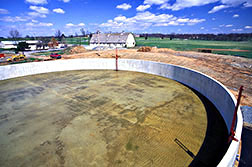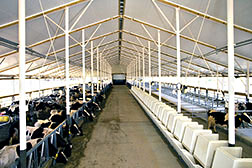Making the Most of Manure
Many urban dairy farmers see livestock manure as a problem, especially when it comes to getting along with their neighbors. But manure can also be a source of nutrients for feed crops and a valuable fertilizer for suburban gardeners, too.
Animal, crop, and soil scientists at USDA's Beltsville (Maryland) Agricultural Research Center have joined forces to search for ways to recycle nutrients in dairy manure. Four Agricultural Research Service research labs, one in ARS' Livestock and Poultry Sciences Institute (LPSI) and three in its Natural Resources Institute (NRI), are involved.
“The key to this research is keeping nitrogen and other nutrients in a cycle found on every dairy farm,” says project leader Robert J. Wright, who is with the NRI’s Environmental Chemistry Laboratory. “It’s a matter of capturing and storing the nutrients in dairy manure and then applying them to the soil to nourish crops, which, in turn, feed the livestock. All the while, we’re focusing on keeping farms profitable, protecting soil and water quality, and preventing odors.”
"Actually, profits and environmentally sound management can go hand in hand," says ARS dairy scientist Barbara P. Glenn. She heads the LPSI's Nutrient Conservation and Metabolism Laboratory.
"Dairy producers are paid based on the protein in cows' milk. So, if more of the nitrogen in feeds ends up as milk protein, it's good for business," says Glenn.
This kind of cooperative research is going to be more vital in the future.
Bedroom communities near dairy farms are increasingly concerned about environmental impacts. In fact, right-to-farm laws, which protect responsible farmers from frivolous lawsuits from nonfarming neighbors, have popped up nationwide. Giving farmers simple methods to reduce odors can improve their relationship with area residents and possibly head off legal conflicts.
Diet might be one area where farmers could make subtle changes with big results.
Normally, only 25 percent of the nitrogen fed to an animal is recovered as milk protein. The rest is excreted, with as much as half escaping into the air as ammonia gas and other odorous compounds. Less than 35 percent of the nitrogen is left to recycle as a nutrient for crops. A change in feeds might reduce the nitrogen waste and add to the nutritional value of a cow's milk.
Glenn's group is exploring how the cows' diet can be formulated to improve nitrogen efficiency. Chemist James B. Reeves is working to develop rapid on-farm tests to gauge the nutrients in livestock manure so farmers will know its fertilizing potential. Other researchers are trying to identify compounds to absorb nitrogen from manure on the barn floor, to enhance the value of manure fertilizer and reduce odors.
 Manure collection tank at the Beltsville (Maryland) Agricultural Research Center. (K5791-6) |
The loss of nitrogen as ammonia occurs in the barn, during storage, and after land application. But ammonia is only a part of the odor problem; a host of compounds contribute, and some are not even identified yet. Biomedical engineer Alan M. Lefcourt will measure the amount and types of gases lost, both from dairy cows and their manure.
An important part of this research project is its interconnectivity. Each researcher's work complements that of others. For example, if Glenn's group can help farmers choose the right feeds and develop tests to analyze for manure nutrients, producers will still need effective ways to apply the manure.
Soil scientists Rodney Thompson and Jack Meisinger, who are with the NRI's Environmental Chemistry lab, have been looking at that aspect.
"Farmers usually broadcast manure on the soil surface because it's the quickest and cheapest way of getting it on the land," says Thompson. "Unfortunately, that opens the door for potentially valuable nitrogen to evaporate as odor-causing ammonia."
But if farmers plow under the manure—effectively mixing it with the soil—they can prevent this loss, the scientists say. They plan to compare nitrogen losses in plowed and spread fields to demonstrate that this technique is worth the extra effort.
"Having the manure on the surface creates an ideal situation for gas exchange, and that's what ammonia evaporation really is," Meisinger says. "You lose almost half of the available nitrogen because the manure is sitting on the surface. But soils absorb ammonia very nicely if you just get that soil contact."
Another way farmers could someday profit from their herds' manure is by selling it to suburban homeowners as a composted product.
This is the research goal of Lawrence J. Sikora, who is with NRI's Soil-Microbial Systems Laboratory. Sikora's expertise lies in finding effective new ways to make crop-fertilizing compost out of waste products. Sikora is exploring how municipal waste could be combined with manure, a process known as co-composting, to make an effective fertilizer.
Sikora says that cities could remove the glass, plastic, and metal from their trash for recycling because they offer no benefits to plants. What's left is a high-carbon mix such as paper products and leftover food—all of which are good for composting. It's just that the resulting compost has a problem.
"With so much carbon-based material, this compost is very deficient in nitrogen," says Sikora.
“Seedlings would come up yellow if you put this compost on the soil. That’s because microorganisms in the compost material are actually taking the soil’s nitrogen from the plants.”
Making an urban-dairy manure compost could solve lots of problems, but it also presents challenges. Though composting is not odor-free, these odors are manageable. And to make the effort of composting worthwhile, the product created has to have market value. Sikora's colleague, microbiologist Patricia D. Millner, is looking at co-composting from these practical angles.
But any solutions found during this research must also keep farms profitable. That's why the team also includes economist Yao Chi Lu. Lu will be reviewing all the research to ensure that any whole-farm system designed by researchers allows the farmer to make money, protects the environment and keeps the farm in the family for generations to come.
"Right now a lot of this research is just getting started," says Lu. "So I'm preparing myself by becoming acquainted with everything about dairy operations and how they make profits. That way I can design computer models that will tell us whether these ideas will allow farms to prosper--not only a year from now, but 30 years later." -- By Jill Lee, ARS.
Robert J. Wright is at the USDA ARS Natural Resources and Sustainable Agricultural Systems, 10300 Baltimore Ave, Beltsville, MD 20705-5140; phone (301) 504-4638.







